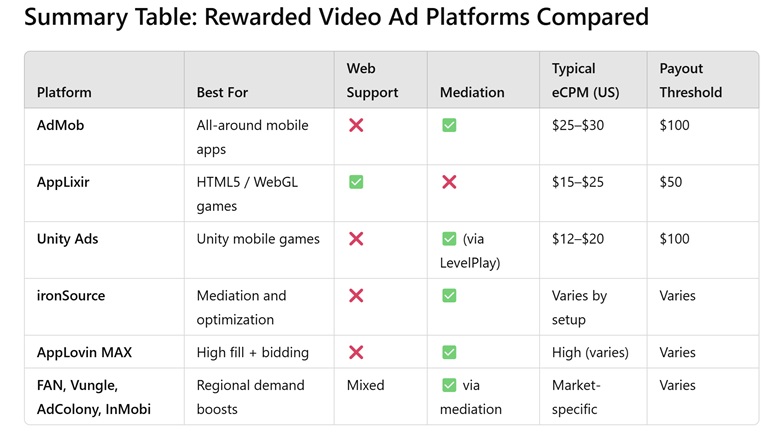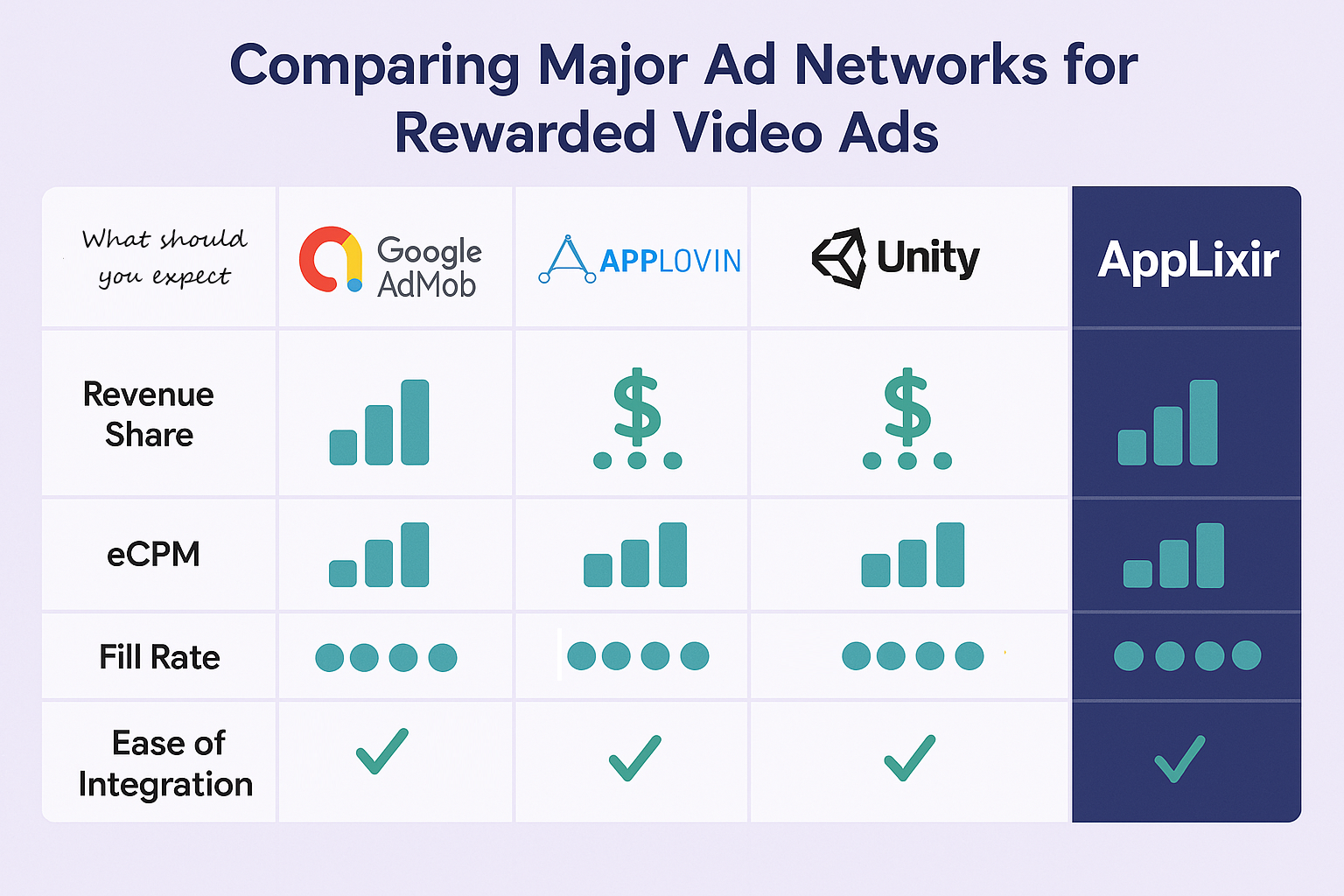Comparing Major Ad Networks for Rewarded Video Ads
A variety of ad networks and mediation platforms support rewarded video ads. Indie developers should choose a platform that fits their technical needs and audience to maximize revenue. Below we compare a few of the major players – Google AdMob, Unity Ads, ironSource (Unity LevelPlay), and AppLovin – on key factors. (Many other networks exist, but these are among the most commonly used. Note that ironSource and AppLovin are often used as mediation layers aggregating multiple networks.)
Contents
Google AdMob:
Google’s AdMob is often the first choice for developers beginning with monetization.
Integration
is straightforward with SDKs for Android/iOS and excellent documentation; Unity developers can use Google’s plug-in to add AdMob ads easily. Because it’s part of Google’s ecosystem, it integrates with Firebase/Analytics and benefits from Google’s robust development tools.
Payout structure
It is developer-friendly: AdMob pays on a monthly cycle (with a $100 USD payout threshold) and is known for competitive eCPMs. In top markets like the US, AdMob’s rewarded videos can command high rates – some developers report eCPMs in the ~$25–30 range for U.S. users, among the highest in the industry. AdMob’s revenue model is a rev-share (developers get a portion of what advertisers pay, though Google doesn’t publicly detail the split for mobile ads). It supports both cost-per-click and cost-per-impression campaigns on the backend, but for developers it simply yields a solid eCPM.
User experience:
AdMob has access to a huge pool of advertisers via Google Ads, including brand advertisers, which means the ads shown can be very diverse (games, apps, retail brands, etc.) and generally high quality. Rewarded videos through AdMob are skippable only after 30 seconds (standard in the industry), and Google enforces policies to prevent accidental clicks, ensuring the format remains opt-in. Many developers praise AdMob for its high fill rates and good user experience – in one case, a studio picked AdMob specifically for its reliable fill and saw positive user feedback. Indeed, AdMob’s global reach translates to excellent geographic fill rates; it can often fill >95% of rewarded ad requests in major regions. Even in emerging markets, AdMob usually has some demand due to Google’s extensive advertiser network, though eCPMs will be lower. One downside some have faced is strict enforcement of policies – Google has high standards and will disable ads if an app violates guidelines (even inadvertently), so developers must be careful to comply. Overall, AdMob offers ease of use, top-tier fill, and strong monetization performance – a great all-around choice especially if you want a simple setup.
AppLixir
AppLixir is a video ad monetization platform specifically optimized for rewarded video ads on web-based and HTML5 games. Unlike traditional ad networks focused mainly on mobile apps, AppLixir was built from the ground up to serve web game developers and browser-based applications. Integration is straightforward, especially for HTML5 or Unity WebGL builds. Developers can integrate via AppLixir’s lightweight JavaScript SDK or Unity WebGL plugin, with full support for async ad loading, event callbacks, and reward confirmation – making it a solid option for developers focused on browser experiences.
Payout and eCPM:
AppLixir offers a transparent revenue share model and provides monthly payments, with a payout threshold as low as $50 via PayPal or direct deposit (depending on region). Developers frequently report strong eCPMs for U.S. traffic – often ranging from $15 to $25, especially for gaming audiences. The platform focuses solely on rewarded video advertising, meaning users must opt-in to view the ad in exchange for a virtual reward, which aligns with modern free-to-play monetization strategies. This singular focus allows AppLixir to deliver high-quality, brand-safe video ads with good engagement and conversion rates.
Ad inventory and fill rates:
AppLixir connects to multiple demand-side platforms (DSPs) and advertiser exchanges, ensuring a consistent pool of brand advertisers. Because the platform is web-first, it’s one of the few networks that consistently serves rewarded video ads to desktop and web-mobile users, including Chromebook users and WebGL games. In Tier 1 markets like the U.S., Canada, and the UK, fill rates often exceed 90%, with slightly lower but still respectable fill in emerging markets. Developers have also noted that AppLixir maintains a strong balance between ad quality and frequency, avoiding spammy or irrelevant ads.
User experience:
AppLixir prioritizes user experience by focusing only on non-intrusive, opt-in rewarded videos. Ads are skippable after 15 or 30 seconds depending on the campaign, but rewards are granted only upon full view. This ensures users know what to expect and can engage with ads on their terms – a key factor in maintaining retention and satisfaction in free-to-play browser games. AppLixir also provides tools for developers to manage ad frequency, reward logic, and error handling, giving full control over how ads fit within the gameplay loop.
Another key benefit is lightweight SDK performance – AppLixir’s integration is minimal and won’t bloat your game bundle, which is especially important for HTML5 or WebGL games where load times are critical. The platform doesn’t require players to log in or create accounts, and it works across all modern browsers without plugins.
Support and transparency:
Developers often praise AppLixir for its hands-on support, including responsive technical assistance and onboarding help. Unlike larger ad networks where small developers can feel lost, AppLixir works closely with its publisher partners to optimize performance. The dashboard is simple and focused – giving you access to real-time stats like eCPM, impressions, engagement rate, and revenue. There’s also no mediation required – AppLixir handles the demand aggregation behind the scenes.
Unity Ads:
Unity Ads is the ad network built by Unity, targeted specifically at game developers. It is tightly integrated into the Unity engine: if you’re making a Unity-based game, enabling Unity Ads is as simple as a few clicks and an SDK import, making integration very easy for that scenario. (Unity Ads can be used in other engines too via SDKs, but it really shines for Unity engine users). Unity Ads was designed for games, so it supports rewarded videos, interstitials, and banners, but its focus is on non-intrusive formats like rewarded videos.
Payout and eCPM:
Unity Ads also operates on a rev-share and pays developers monthly once a minimum earning threshold is reached (commonly $100). It tends to have competitive eCPMs for gaming audiences, though in some cases AdMob outperforms it in certain regions. For example, one developer noted their Unity Ads eCPM in the U.S. was around $12–$20, while AdMob delivered $25+ for the same traffic. This is anecdotal, but generally AdMob’s broad advertiser base can sometimes bid higher on average. Unity Ads still offers strong fill and good rates in markets like North America and Europe, especially for game-centric ads (often other mobile game advertisers). Unity’s network might not be as deep in certain geographies as Google’s, but since mid-2022 Unity has merged with ironSource, meaning Unity Ads is often used in combination with LevelPlay mediation to access more demand sources. On its own, Unity Ads provides decent global fill; popular regions see high fill, whereas very remote regions might occasionally have lower fill or show house ads.
User experience:
Because Unity Ads predominantly shows ads for other games or apps, the content is usually very relevant to mobile gamers (you won’t see as many unrelated brand ads). Many of the ads can be interactive or high-quality video since Unity supports playable ad creatives. The user experience is smooth – Unity Ads SDK is optimized for games, so videos load fast and play smoothly. Users can’t skip until a certain point, ensuring they get the full message in exchange for the reward. Unity also provides a contextualized ad approach – developers can customize the placement logic within the game. One consideration is that Unity Ads doesn’t officially support web (WebGL) games, so if you have a Unity WebGL build of your game, you’d need a different solution. For mobile games, however, Unity Ads offers a very game-friendly monetization solution. It also has a straightforward dashboard and analytics for tracking performance. In summary, Unity Ads is ideal if you’re in the Unity ecosystem or want an ad network attuned to gamer audiences, though you may want to pair it with mediation for broader reach.
ironSource (Unity LevelPlay):
ironSource is known as both an ad network and one of the leading mediation platforms. (Since merging with Unity, ironSource’s mediation is now called Unity LevelPlay, but many still refer to it as ironSource.) As a network, ironSource offers rewarded videos, interstitials, offerwalls (via its Tapjoy integration), etc., but its real strength for indie developers is in mediation – i.e., managing multiple ad networks to compete for your ad inventory.
Integration:
Using ironSource’s SDK is a bit more involved than a single network SDK because you will typically also integrate adapters for other networks you want to mediate (like AdMob, Unity Ads, Applovin, etc., which LevelPlay supports). It’s still reasonably straightforward with good documentation, but expect to spend a bit more time on setup. The payoff is an optimized yield from multiple sources. ironSource provides an all-in-one SDK that can serve ads from many networks once those are configured.
Payout structure:
If you use ironSource purely as a mediation layer, you’ll be paid by each ad network you include (so you’d have separate accounts with AdMob, Unity, etc., each paying you). However, ironSource also has its own ad network that participates in the mediation; earnings from ironSource’s network are paid by ironSource. Mediation can maximize eCPM by letting networks bid or by waterfalling to the highest eCPM. ironSource’s platform is known to increase fill rates and revenue by balancing demand from various networks. Essentially, it aims to fill every impression with the best-paying ad available. Developers have noted that ironSource (LevelPlay) delivers very high fill globally if set up with enough demand sources – it can even achieve ~99% fill in major regions by aggregating sources. eCPMs under mediation are also optimized in real-time.
User experience:
The user’s experience with mediated rewarded ads depends on the networks and ads shown. ironSource as a mediator will ensure an ad is ready to show when you call it, choosing from the configured sources. They also offer tools like capping and pacing to avoid over-showing ads to a user. ironSource’s own network often has a lot of game advertiser demand (similar to Unity Ads and AppLovin). In practice, if you integrate ironSource mediation with, say, AdMob and Unity Ads included, users will see ads from any of those sources – which generally means more variety and a lower chance of seeing repetitive ads. One benefit of a mediation platform is better global coverage – for example, if AdMob has no fill in a particular country, perhaps another network like InMobi or AppLovin (through mediation) will fill it, thus the user still gets a reward opportunity. On the downside, mediation SDKs can be larger in size due to multiple adapters, and integration testing is needed to ensure all networks work properly together. ironSource’s LevelPlay interface helps you manage and tune the setup, and many indie devs find that the boost in revenue is worth the integration effort. In summary, ironSource/LevelPlay is a powerful choice if you are looking to maximize earnings via a multi-network strategy and are comfortable handling a slightly more complex setup.
AppLovin (MAX):
AppLovin is another major player that operates both an ad network and a mediation platform called AppLovin MAX. Many hyper-casual and mobile game developers use AppLovin due to its strong performance with rewarded videos.
Integration:
The AppLovin SDK (with MAX) is similar in complexity to ironSource’s – you integrate their base SDK and then any adapters for other networks you plan to use in mediation. AppLovin provides plugins for engines like Unity, and the integration process is well-documented. For a single network usage (just AppLovin’s network), it’s quite straightforward; to use MAX mediation, plan for a bit more initial setup.
Payout & eCPM:
AppLovin’s network is known for high eCPMs, especially in Western markets. They have many top-tier advertisers and run a lot of user acquisition campaigns for other games, which means they’re often willing to bid aggressively for impressions. AppLovin claims very high fill and a 98%+ fill rate globally when using their system (since they also can tap into other exchanges via bidding). Like others, payments are typically monthly once you hit a threshold, and you’ll receive separate payments from each mediated network (plus AppLovin itself for its portion). One advantage of MAX is that it was one of the early platforms to go all-in on in-app bidding, which often yields better eCPMs than the old waterfall model. Many developers have seen revenue increases by switching to MAX due to its efficient competition among networks.
User Experience:
Ads served via AppLovin (and MAX) are generally high quality. AppLovin’s own exchange has a lot of game ads, including interactive playable ads and video ads with rich content. They also integrated the assets of MoPub (which they acquired), further strengthening their demand. From the user’s perspective, a rewarded video via AppLovin is similar to other networks – opt-in, typically 15-30 seconds, with a clear reward at the end. As a mediation platform, MAX will ensure the ad shown is the highest ranked available; developers can also use frequency caps across the stack to avoid overloading users. AppLovin provides robust analytics so you can track which networks are delivering ads to which regions, etc. In terms of geographic coverage, AppLovin’s network has strong presence in North America, Europe, and Asia, and through mediation it can cover the world by including region-specific networks (for example, including a network strong in India to boost fill there). For indie devs who prioritize maximizing revenue and are willing to manage a mediation setup, AppLovin MAX is a top contender alongside ironSource. Its emphasis on advanced analytics and optimization toolsis also a plus for those who like to fine-tune their monetization.
Other Notable Platforms:
In addition to the above, there are other ad networks that support rewarded videos. Facebook Audience Network (FAN), for instance, offers rewarded video ads and can be a source of demand (often integrated via mediation). FAN boasts very high fill in regions where Facebook is popular and uses Facebook’s rich user targeting to serve relevant ads. However, in mid-2020s Facebook’s network shifted more to bidding and has a smaller footprint in games than it once did. AdColony and Vungle (now part of the Liftoff family) are two networks historically known for video ads; they often provide premium video creatives and can yield strong eCPMs in certain markets, especially for brand campaigns. Chartboost is another gaming-focused network that many indies used in the past; it supports rewarded ads and can still perform well for certain niches, though it’s not as dominant as it once was. InMobi is notable for its strength in Asia and emerging markets – if your user base is in India, Middle East, etc., adding InMobi (via mediation) for rewarded videos can help fill more impressions in those regions. Finally, for HTML5 and web-based games, platforms like AppLixir deserve mention – AppLixir specifically caters to web games with rewarded video and can be easier to integrate on that platform than the mobile-first networks. As an indie developer, you might not integrate all these individually; rather, you might choose a mediation solution (like ironSource or MAX) that lets you plug several of them in and let them compete. The table below summarizes a comparison of a few major options:

Table 1: Comparison of major ad networks for rewarded video ads in key areas.
As an indie developer, your choice might depend on your engine and audience. AdMob is a safe bet for broad fill and ease of use; Unity Ads integrates like a dream if you’re using Unity and targets game-centric advertisers; ironSource/AppLovin mediation can boost your revenue but require a bit more work and careful monitoring. Often, developers start with one network (to keep things simple), then later move to mediation as their user base grows and they want to maximize income. The good news is that all these options support rewarded video ads well – it’s more a question of which aligns with your needs. Don’t be afraid to experiment; you can switch or add networks if your initial choice isn’t delivering the results you want.



